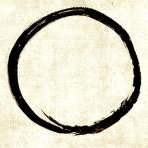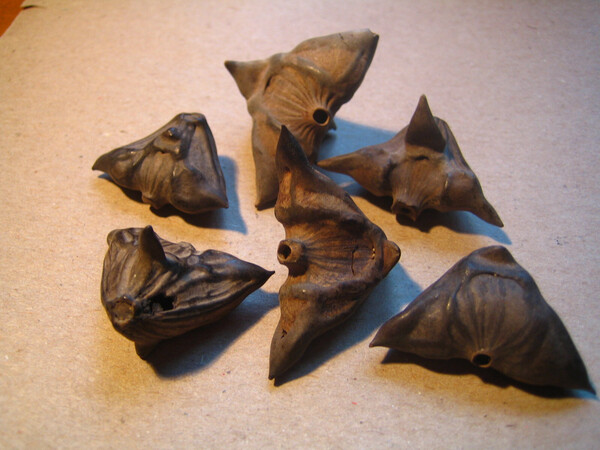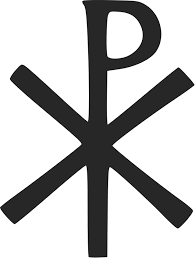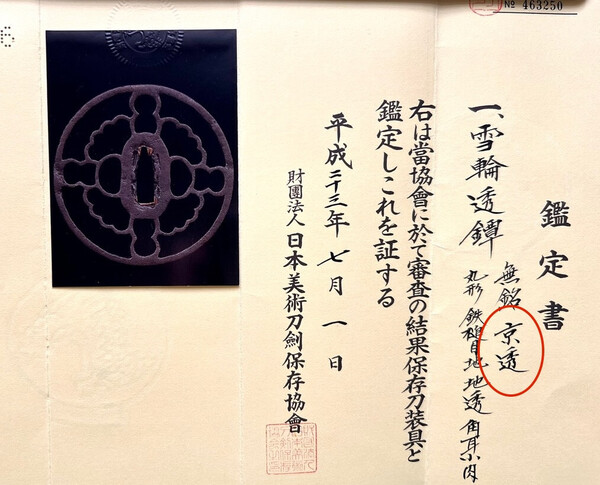-
Posts
380 -
Joined
-
Last visited
-
Days Won
1
Content Type
Profiles
Forums
Events
Store
Downloads
Gallery
Everything posted by FlorianB
-
There’s another explanation that the matsukawa-bishi is actually derived from the fruits of water-caltrop, called "hishi" 菱. BTW: The matsukawa-bishi pattern is a very old design and could be found on textiles in the Shoso-in already. Best, Florian
-
A note about the Lotos Sutra Tsuba. It seems, that the Kanji form a caterpillar. Coincidental or is there a connection to the theme? Florian
-
Usually habaki are made of copper, often with silver or gold plating, sometimes shakudo is used. Yours look like copper, too. Maybe an alloy with iron or iron layer? FYI: Have a look at this thread: https://www.militaria.co.za/nmb/topic/32583-cat-scratch-habaki/ with a lot of wonderful examples of habaki. Florian
-
Zachary, I think the Japanese dealer had the Chi-Rho-symbol of the early christianity in mind: However, without the curve at the top it means all and everything. Also I doubt this particular symbol could be connected with the Jesuits in Japan. We must have in mind, that the composition on many Tsuba simply plays with the horizontal, vertical and/or diagonal axes. Best, Florian
-
I think a lot of Tsuba advertised as „christian“ have none or only a doubtful connection to Christianity. But obviously it sells! Look at this „crosses“ and „Crown of Thorns“ : https://zentnercolle...of-tsuba-with-stand/ There are Tsuba with religious background, Kanji forming „Namu Amida Butsu“, religious items or holy persons are depicted, but on more abstract motives it is in the eye of viewer to recognize a religious interpretation. Best, Florian
-
Hi Steve, indeed there is no strikt rule for the width of a tang. In general it could be said, that a slender blade has a slender tang, a sturdy blade has a sturdy tang. So I persume that Tsuba was once fitted for a more elegant blade. I like this Tsuba, exactly my taste! On the left and right are myoga. The rectangels may be a reminiscence to an ancient design or perhaps are genji chapter mon. Best, Florian
-
I wonder why do You want to know? Are You afraid, You paid too much for Your piece? Or did You made a bargain and can’t believe it? At least - as it is was said different times here: The value is what someone pays for it. Best, Florian
-
Quality depends on different parameters, for example handling of the material, craftsmanship, state of preservation and to a certain degree the age. Age could explain and sometimes excuse blemishes on the piece. My advice to a beginner: Look at as many Tsuba as possible to learn. Best in hand, but good pictures will do also, today easily available online. Concerning Your Tsuba the workmanship is certainly not top quality. Whereas the vertical axis out of alignment was made intentionally and could be seen on many pieces, the rim and the sukashi openings lack diligence. However, it is an honest piece and nice study material. Enjoy it! Florian
-
There’s another point. If those sprinkles are martensite, the piece must have been hardened. But I learned that hardened Tsuba are brittle and could break so softer iron was in use. What is to make out of it? Florian
-
Hi, it’s a nice Wakizashi-Tsuba for beginners and I agree with the mid-/late-Edo attribution. Concerning the motif I’m not sure if it refers to a buddhistic custom to buy catched birds and set them free. It seems to consist of iron and the technique used is called "nunome", i.e. gold foil is applied to the surface. You can see criss-cross roughenings in the ground so the gold can stick on it. Alas this gold could be abraded by careless handling what would explain the missing parts in the cage. The soft metal inlets in the tang hole are called "sekigane" and are used to hold the Tsuba tight on the tang. The tang hole ("nakago ana") was usually produced in a certain size, but specifications to a particular sword tang has to be done later by hammering the sides to narrow it or filling the gaps with soft metals usually copper. In Your specimen the position of the sekigane hint to a small tang, probably a dagger. Best, Florian
-
Thank You, Geraint. Good hint, this could be the solution. Easy to see, hard to photograph. Couldn’t get the sparkling correctly. But next try. Maybe those will clarify. Florian
-
Owari would be my guess, too. However, that’s what the paper says: But folks, PLEASE! Take it as it is. Not that vexed discussion about papers again! DON'T! Florian
-
Hi Jean, here are some shots of the complete piece, however I haven’t managed to get better close-ups because of the lack of professional photo equipment. But I try again. The above close-ups show the curves at the bottom. Best, Florian
-
Thank You for the input. It's an older piece, so patination should be old, too. At least it needs further investigation. Florian
-
I understand that tekkotsu appears in the rim area and consists of granular or linear embossed elements. In this case here we have flat dots all over the plate, which are gleaming in angular light, but are black in normal view. Florian
-
Hello all, examining one of my Tsuba I recognized tiny bright spots if light falls on them aslope. Those are scattered irregularly all over the surface. Sorry for the mediocre quality of my shot, but I hope You get the idea. Another picture of the same area in a steeper angel for comparison shows that these spots are no abrasions. Seeing such sprinkles on a blade I would call them „nie“, but on Tsuba, too? I haven’t seen this before. And does it tell something about the material or working process? Best, Florian
-
Hi Colin, it was just an idea. Indeed I haven’t considered the former value of these materials as Jean mentioned. BTW: Have there been models at all? Best, Florian
-
In my eyes the piece seems to be mere a model. Best, Florian
-
Please take into account that knowledge about Tsuba and their motives were very limited in 1922. There are several similar mistakes and misinterpretations in other catalogues at these times as well. BTW: A Tsuba (seen on guiseppepiva.com) reminded me to an „Oktoberfest“-motif several years ago. Cheers! Florian
-
Sorry to be a know-it-all: The correct name is Tsuno Daishi 角大師 (horned grandmaster). Here's an elder thread with examples of this fellow: Best, Florian
-
Hello Jens, I flipped through my books but I haven’t found a similar piece yet. However, Dale showed some already. I agree with his Ito attribution though these show often very fine lines but there are also some like Yours. The surface shows a fine structure by hammer finish (so-called tsuchime). Careful regular rubbing with a cotton cloth will enhance the patination of Your piece. Best, Florian
-
Hi Jens, this was quick! The Tsuba has wakizashi size (meant for short swords) A closer look shows no mokume surface as Peter suggested. I will do some research later. Best, Florian
-
Hi Jens, would You be so kind and give the dimensions? This means height, width and thickness both at the rim and at the nakago ana (the triangular center hole). More pictures in higher resolution would be helpful, too. My quick guess would be an average Tsuba made in Edo-period. There are different artists/schools which worked in kage-sukashi (negative silhouette) at this time. The motif of a goose (karigane) is frequently found on Tsuba, here combined with a swirl of water. Best, Florian
-
„Every single item from The Lanes Armoury is accompanied by our unique Certificate of Authenticity.“ ( thelanesarmoury.co.uk ) Here's one for a pair of menuki: Dealers certificate = a printed piece of paper - nothing to make a fuzz about. Florian
-
The whole Tsuba has a rustic appearance. The kidney-formed openings are typical for Shoami. Ko-Shoami is possible assuming the eyes would have been added later. I noticed in the enlargement file marks which could be a preparation for nunome zogan so IMHO Kyo Shoami seems to be more appropriate. At least there are two possibilities: #1: An Ko-Shoami work has been at a later date prepared for nunome zogan. #2: The work was done at Edo-times by a more rural workshop which lacks the refinement and standards of the capital studios. Best, Florian













